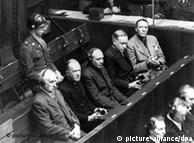HISTORY | 20.11.2010
Nuremberg trials left a lasting legacy
The Nuremberg trials, launched in the wake of World War II, left behind a broad legacy. Successful in sentencing a group of key personalities of the Nazi Party, they inspired a series of further trials all aimed at punishing the war criminals of the Third Reich.
The trials, which began on November 20, 1945, in the Bavarian city of Nuremberg, were a new type of event on the world stage. It was the first time an international tribunal had sought to sentence the leaders of a regime - politicians, army officers and economic advisors - even though in some cases direct responsibility for specific criminal acts could not be attributed to them.
As a group, they were seen as initiators, aides, organizers and executers of crimes against humanity. They were accused of orchestrating wars of aggression, murdering civilians and prisoners of war, deporting people, plundering, engaging in racial persecution, murdering European Jews and occupying numerous European countries.
However, all these accusations had little impact on the Nazis in the courtroom, who did not see themselves as responsible for the listed crimes. Not a single one plead guilty.
A combined international effort
The judges for the trials came from the United States, the Soviet Union, France and Great Britain and were appointed by their governments for this role.
The chief prosecutor was Robert Jackson from the United States, and his assistant chief counsel was German-Jewish lawyer Robert Kempner, who had been stripped of his German citizenship by the Nazis before World War II and had immigrated to the United States.
"When I began to work on this matter in America in 1942, my American colleagues asked me, 'Is this all true? Can we prove it?'" recalled Kempner. "And I said, 'We can prove this 100 percent.'"
The trials lasted 218 days, with 236 witnesses questioned, 5,330 documents and 200,000 statements submitted as evidence and 25,000 pages of protocol written. The hearings shed light on the dimensions of the Nazi regime's crimes.
The verdicts came out on September 30 and October 1, 1946: seven imprisonments, 12 death sentences and three acquittals.
 The 218 days of trials produced various sentences and 25,000 pages of protocol
The 218 days of trials produced various sentences and 25,000 pages of protocol
Inspiration for further trials
The first round of trials was followed by 12 others. These were aimed at Nazi medical doctors, lawyers, soldiers and even companies such as Flick - an industrial conglomerate that supported the Nazi party. Flick profited from the liquidation of Jewish property, assisted Hitler's rearmament efforts and used slave laborers from concentration camps.
The German population and its attitude towards the Nazi era were largely unaffected by the trials. They were seen as an arbitrary act of the winning side and it was not long before the government of the newly-formed Federal Republic of Germany, together with party and church representatives, pleaded for clemency on behalf of the convicted persons.
Some death sentences were turned into prison sentences, and there were some early releases. Some of the accused got the chance to resume their interrupted careers.
Despite some of these sentences being overturned, the trials left a lasting impression on the world.
The creation of the International Military Tribunal has served as a model for other tribunals, including The Hague in the Netherlands - for trying crimes committed during the Balkan wars - and the International Military Tribunal for the Far East, which tried Japanese officials for crimes against peace and against humanity.
The trials also significantly influenced the development of international criminal law, serving as models for conventions such as the 1948 Convention on Genocide.
Author: Cornelia Rabitz/ew
Editor: Martin Kuebler


No comments:
Post a Comment